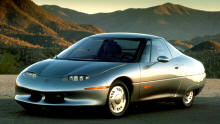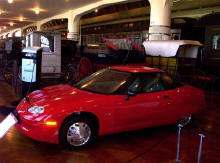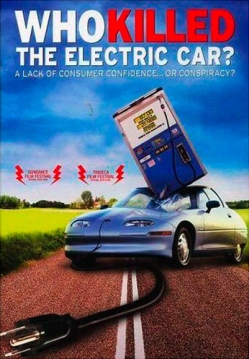History of Electric Vehicles Part V
|
Even as Congress tried to figure out how to pay for the Interstate System, a coalition of electric and power companies encouraged Americans to think about the highways of the future. In the mid-1950s, the coalition published this illustration in popular magazines such as Life to show the wonders of electricity. "Your air conditioner, television and other appliances are just the beginning of a new electric age," the ad said.
During the 1960s, interest in EVs increased due to environmental awareness and a concern about America's international oil dependency. The 1960s and 1970s saw a need for alternative fueled vehicles to reduce the problems of exhaust emissions from internal combustion engines and to reduce the dependency on imported foreign crude oil. Many attempts to produce practical electric vehicles occurred during the years from 1960 to the present. In the early 1960s, the Boyertown Auto Body Works jointly
Several attempts were made to get electric cars off the ground, most notably the 1974 debut of the 36-48-volt Vanguard-Sebring CitiCar. Similar to most EVs of the time, it had a top speed of 44 mph and a range of 50 to 60 miles. Another product of the 70s was the Elcar Corporation’s Elcar, with a top speed of 45 mph and a 60-mile range and cost between $4,000 and $4,500. . Both saw promising sales in the middle of the decade, but went kaput once the oil crisis stopped being... a crisis.
In recent years, increased concerns over the environmental impact of gasoline cars, along with reduced consumer ability to pay for fuel for gasoline cars, and the prospect of peak oil, has brought about renewed interest in electric cars, which are perceived to be more environmentally friendly and cheaper to maintain and run, despite high initial costs. Electric cars currently enjoy relative popularity in countries around the world, though they are notably absent from the roads of the United States, where electric cars briefly re-appeared in the late 90s as a response to changing government regulations. 1990s to present: Revival of mass interestIn January 1990, GM chairman Roger Smith demonstrated the Impact
(pictured below), an electric concept car, at the 1990 Los Angeles Auto
Show. The car had been developed by electric vehicle company
In the early 1990s, the California Air Resources Board (CARB), the government of California's "clean air agency", began a push for more fuel-efficient, lower-emissions vehicles, with the ultimate goal being a move to zero-emissions vehicles such as electric vehicles. Chrysler, Ford, GM, Honda, Nissan and Toyota also produced limited numbers of EVs for California drivers. In 2003, upon the expiration of GM's EV1 leases, GM crushed them. The crushing has variously been attributed to 1) the auto industry's successful federal court challenge to California's zero-emissions vehicle mandate, 2) a federal regulation requiring GM to produce and maintain spare parts for the few thousands EV1s, and 3) the success of the oil and auto industries' media campaign to reduce public acceptance of electric vehicles.
Honda, Nissan and Toyota also repossessed and crushed most of their EVs, which, like the GM EV1s, had been available only by closed-end lease. After public protests, Toyota sold 200 of its RAV EVs to eager buyers; they now sell at over their original forty-thousand-dollar price. Major car makers, such as Daimler AG, Toyota Motor Corp., General Motors Corp., Renault SA, Peugeot-Citroen, VW, Nissan and Mitsubishi Corp., are developing new-generation electric vehicles. In June 2009 BMW began field testing in the U.S. of its all-electric Mini E, through the leasing of 500 cars to private users in Los Angeles and the New York/New Jersey area. A similar field test was launched in the U.K. in December 2009 with a fleet of more than forty Mini E cars. The Nissan LEAF, due to be launched in 2010, is the first all electric, zero emission five door family hatchback to be produced for the mass market. Lithium-ion battery technology, smooth body shell and advanced regenerative braking give the LEAF performance comparable to an ICE, a range of around 160 km and the capability to reach 80% recharge levels in under 30 minutes. The Chevrolet Volt, due to be launched in November 2010 as a 2011 model. The Chevrolet Volt is a plug-in hybrid electric vehicle (PHEV). For up to the first 40 miles (64 km), the Volt is powered by electrical energy stored in its on-board lithium-ion batteries which are charged by connection to an electrical power outlet.
Some information extracted from Wikipedia, the free encyclopedia: Text is available under the
Creative Commons Attribution-ShareAlike License; additional terms
may apply. See
Terms of Use
for details.Significant material
contributed by Galen Handy |
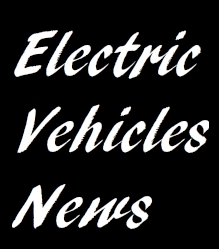
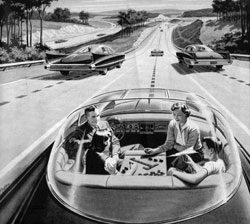
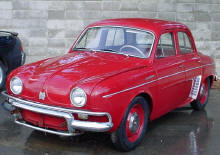
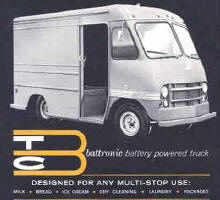
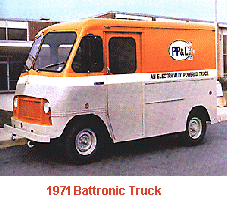 Battronic
worked with General Electric from 1973 to 1983 to produce 175 utility vans
for use in the utility industry and to demonstrate the capabilities of
battery powered vehicles. Battronic also developed and produced about 20
passenger buses in the mid 1970s.
Battronic
worked with General Electric from 1973 to 1983 to produce 175 utility vans
for use in the utility industry and to demonstrate the capabilities of
battery powered vehicles. Battronic also developed and produced about 20
passenger buses in the mid 1970s. 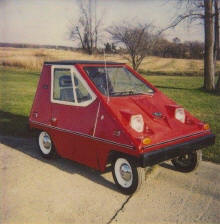

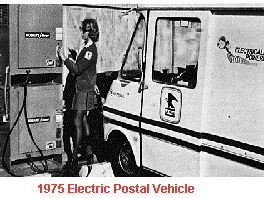 In 1975 the United States Postal Service purchased 350 electric
delivery jeeps from the American Motor Company to be used in a test
program. These jeeps had a top speed of 50 mph and a range of 40 miles at
a speed of 40 mph. Heating and defrosting were accomplished with a gas
heater and the recharge time was 10 hours.
In 1975 the United States Postal Service purchased 350 electric
delivery jeeps from the American Motor Company to be used in a test
program. These jeeps had a top speed of 50 mph and a range of 40 miles at
a speed of 40 mph. Heating and defrosting were accomplished with a gas
heater and the recharge time was 10 hours. 